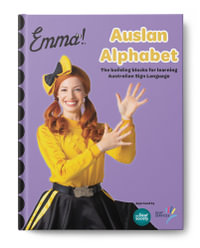| List of Figures | p. ix |
| Acknowledgments | p. xv |
| Introduction: Language and the People Who Use It | p. 1 |
| Languages of Signs | p. 2 |
| Goals of this Book | p. 4 |
| The Linguistic Structure of Israeli Sign Language | p. 11 |
| The Basic Components of the Word in Sign Language | p. 19 |
| The Meaningless Building Blocks of Words | p. 19 |
| The Meaningless Building Blocks of Signs | p. 22 |
| Additional Formational Characteristics of Signs | p. 26 |
| Signing It Right | p. 30 |
| The Phonology of Sign Language as a System | p. 32 |
| Sequentiality and Simultaneity in Phonology of Signed and Spoken Languages | p. 35 |
| Conclusion | p. 36 |
| Suggestions for Further Reading | p. 36 |
| Vocabulary: Simple and Complex Words | p. 37 |
| Difficulties in Finding and Recording the Words: The Lexicographer's Lament | p. 39 |
| The Expressiveness of the ISL Lexicon: Words of Communication | p. 43 |
| Adding New Words and Building Complex Words | p. 46 |
| Novel Word Formation in Poetry | p. 55 |
| Suggestions for Further Reading | p. 58 |
| Grammar in Space: The Pronominal System | p. 59 |
| Points of Reference: The Basis of the Pronoun System in Sign Language | p. 60 |
| The Pronominal System in Sign Languages | p. 61 |
| Reference Points as a Means of Avoiding Ambiguity | p. 63 |
| Other Pronouns in ISL | p. 66 |
| Marking Number in the Pronominal System | p. 68 |
| Indicating Reference with the Body: Role Shift | p. 69 |
| Pronouns in Other Sign Languages | p. 71 |
| Conclusion | p. 72 |
| Suggestions for Further Reading | p. 73 |
| Grammar in Space: Verb Agreement | p. 75 |
| What Is Verb Agreement? | p. 76 |
| Verb Agreement in Sign Languages | p. 78 |
| The Form and Meaning of Sign Language Verb Agreement | p. 81 |
| Verb Agreement: Signed versus Spoken Languages | p. 85 |
| Marking Number with Agreement Morphemes | p. 86 |
| Conclusion | p. 87 |
| Suggestions for Further Reading | p. 88 |
| Tenses and Aspects | p. 89 |
| Tense versus Aspect | p. 90 |
| The Aspectual System of ISL | p. 91 |
| The Expression of Time | p. 100 |
| Conclusion | p. 106 |
| Suggestions for Further Reading | p. 106 |
| Shapes, Locations, and Motion in Space: Classifier Constructions | p. 107 |
| What Are Classifiers? | p. 108 |
| When Do You Use Classifiers? | p. 112 |
| Classifiers in Different Sign Languages | p. 117 |
| Classifiers in Spoken Languages | p. 118 |
| Conclusion | p. 119 |
| Suggestions for Further Reading | p. 120 |
| Word Order | p. 121 |
| Topics First, and Then Comment | p. 123 |
| How Is the Topic Determined? | p. 126 |
| Word Order in Possessive Constructions | p. 127 |
| Topic-Comment in Other Languages | p. 129 |
| Conclusion | p. 131 |
| Suggestions for Further Reading | p. 132 |
| Negative and Interrogative Sentences | p. 133 |
| Negative Sentences | p. 134 |
| Interrogative Sentences | p. 147 |
| Conclusion | p. 156 |
| Suggestions for Further Reading | p. 156 |
| Beyond the Hands: Facial Expression in ISL | p. 159 |
| How We Say What We Say: The Prosodic Structure of Language | p. 160 |
| Prosodic Structure in ISL and Intonation on the Face | p. 163 |
| Facial Expression as Part of a Word | p. 171 |
| Facial Expression as a Modifying Morpheme | p. 173 |
| Mouthing | p. 176 |
| Nonlinguistic Facial Expression: The Intonation of Emotions | p. 179 |
| Conclusion | p. 179 |
| Suggestions for Further Reading | p. 180 |
| Summary and Conclusion | p. 181 |
| The Language and Its Community | p. 183 |
| The History of the Deaf Community in Israel | p. 185 |
| The Origins of the Community: A Few Friends and a School | p. 185 |
| The Educational System and its Changing Attitudes toward Sign Language | p. 197 |
| Deaf Society and Culture Today | p. 210 |
| Snapshot of the Community | p. 213 |
| Suggestions for Further Reading | p. 216 |
| The Emergence and Development of ISL | p. 217 |
| The Impact of Other Sign Languages on Israeli Sign Language | p. 218 |
| Stages in Vocabulary Development | p. 224 |
| Conclusion | p. 235 |
| Suggestions for Further Reading | p. 236 |
| Voices from the Community | p. 239 |
| A Student's Journal | p. 240 |
| From Bad Girl in Class to Honored Teacher | p. 244 |
| The Awakening | p. 248 |
| The Big Picture: ISL and Linguistic Theory | p. 253 |
| Similarities and Differences Across Sign Languages | p. 255 |
| The View that Sign Language is Universal | p. 256 |
| Comparative Studies of Sign Languages | p. 259 |
| Differences Across Sign Languages | p. 270 |
| Communication among Deaf Signers of Different Languages | p. 271 |
| Conclusion | p. 274 |
| Suggestions for Further Reading | p. 274 |
| The Contribution of Sign Languages to Linguistic Research | p. 277 |
| The Goal of Modern Linguistics: Characterizing Human Linguistic Ability | p. 278 |
| How Sign Languages Help to Identify Universal Characteristics of Language | p. 284 |
| Language out of Nothing: Communication Systems that have Developed Without a Language Model | p. 292 |
| The Contribution of Research on Israeli Sign Language | p. 298 |
| Conclusion | p. 304 |
| Suggestions for Further Reading | p. 304 |
| List of Handshapes of Israeli Sign Language | p. 307 |
| Main Places of Articulation of Israeli Sign Language | p. 309 |
| Notational Conventions | p. 311 |
| References | p. 313 |
| Author Index | p. 323 |
| Subject Index | p. 327 |
| Table of Contents provided by Ingram. All Rights Reserved. |
























